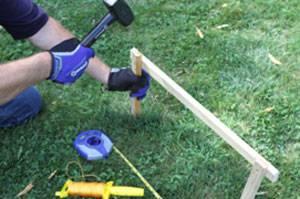Last Updated on April 9, 2024 by chanuka chanuka.23e2
Much of the privacy, shade, and ambience of a landscape comes from arbors, fences, gazebos, and other structures that use vertical posts. If the structure it to last, the posts need to be firmly anchored in the ground. You have two techniques at your disposal: You can bury part of the post in the ground or fasten it above ground to a concrete pier and footing. In packed soil that is not sandy or moist, set the post in an earth and gravel base. In sandy, loose, or moist soil, set the pots in concrete.

”Yveginy and father are an excellent team. They were efficient, prompt, attentive, and well worth the price. They were much better than the other contractors from whom getting quotes was even a challenged. The rails make quite a difference to the look of our house and it stands out! At the end they suggested brushed gold paint on the top of the rails to match our brass fixtures – great idea and we have received an uncanny number of compliments on RAILS!!! I would definitely hire them again for larger jobs. “
Laying Out The Site
 Using batter boards and mason’; line, lay out the perimeter of your fence or other structure and square the corners with a 3-4-5 triangle. Many fences and overhead structures have posts spaced 8 feet apart; your site and design may require different spacing. Lumber is sold in even-numbered increments, so space the posts in even multiples of feet to avoid wasting material. If you use factory-made panels, place the posts precisely. Measure carefully or lay the panels on the ground to determine post locations. (If you’re using prefabricated panels you can mark and dig postholes as you go. This method involves setting a post, holding a panel in place, marking the next hole, and digging it.)
Using batter boards and mason’; line, lay out the perimeter of your fence or other structure and square the corners with a 3-4-5 triangle. Many fences and overhead structures have posts spaced 8 feet apart; your site and design may require different spacing. Lumber is sold in even-numbered increments, so space the posts in even multiples of feet to avoid wasting material. If you use factory-made panels, place the posts precisely. Measure carefully or lay the panels on the ground to determine post locations. (If you’re using prefabricated panels you can mark and dig postholes as you go. This method involves setting a post, holding a panel in place, marking the next hole, and digging it.)
Depth And Diameters
Here are some guidelines for posthole dimensions. Consult your local building department for information specific to your area.
Posthole diameter:
The minimum diameter of the posthole depends on the footing:
- Earth-and-gravel backfill: Make your posthole diameter at least twice the width of the post. A 4×4 requires an 8-inch diameter, a 6×6, a 12-inch diameter.
- Concrete footings: Make the posthole diameter at least three times the width of the post. A 4×4 post requires a hole 12 inches in diameter; a 6×6 requires one 18 inches in diameter.
posthole depth:
- Terminal posts: As a general rule, one-third of the total post length should be below ground (at a minimum depth of 24 inches) and two-thirds above ground. Thus, a 6-foot terminal post should be
- 9 feet long, set in a 3-foot posthole.Line posts: These can be set slightly less deep. Line posts for a 6-foot fence can be 8 feet long set in 2-foot holes. Local codes may require depths below the frost line.
Sinking A Post
- Using a posthole digger, dig a hole that is three times as wide as the post and half of its exposed length.
- Shovel in 4″ of gravel and set the post in the hole.
- Plumb the post and brace it.
- Then shovel in 2 more inches of gravel.
- Complete the earth and gravel installation, or fill the hole with concrete.
Setting Posts
Dadoed or mortised joints require posts cut to a precise height. With other styles, let the height run wild and cut the entire line later. Here’s what to do:
Divide the actual size of your posts by 2 (a 6×6, for example, measures 5/2 inches thick) and move your mason’s lines this distance away from their original position. This new position will place the line in the plane of the outside post faces.
- Stand an end post in its hole and twist its base into the gravel bed about 2 inches. On two adjacent sides and about two-thirds up the post, pivot 1×4 braces on a single duplex nail (its two heads make removal easy). Then plumb the post on two adjacent faces with a 4-foot carpenter’s level or post level, keeping the post face just touching the mason’s line. Stake the braces securely, attaching them to the post with a couple of box nails or screws. Repeat the process for the other end posts.
- To help keep the intermediate posts straight, stretch another line between the end posts about 18 inches below their tops. Then set, align, and brace each successive intermediate post.
- When all the posts are braced, shovel in the footing filler, either earth and gravel or concrete. Double-check each post for alignment and plumb. If you’ve installed concrete footings and you plan to fasten the rails and infill with screws, you can cut the posts and build the rest of your fence or overhead after the concrete sets. If you’re going to nail your fence frame, wait until the concrete cures—three to seven days.
In either case, leave the braces in place.
Cutting Posts
You’ve set the posts with their heights wild, now’s the time to cut them to length.
- Measure one end post from the ground to the post height and mark it. If the grade is – el, snap a level chalk line from that point
- lie other end post. That will mark all posts I the same height. If you’re building a contoured fence, measure the same distance up the other end post and snap the chalk line between them. Make sure all posts are marked, and resnap the line if necessary.
- Carry the marks around each post with a try square. If you’re building a contoured fence, you will cut at an angle. Carry the marks across the downslope and upslope faces first, then connect these lines on the fourth side.
- Cut each post to height with a handsaw or a reciprocating saw. You’ll be on a ladder, so be careful and, above all, patient, if you use a circular saw, start with it and finish the cut with a handsaw. Sharp blades make the job faster and safer.

 Chat
Chat 








